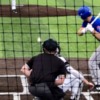I've been seeing a migration of our umpires around here. What used to be a "slot" that effectively split the catcher's stance is becoming a "line up right behind the batter" positioning.
In Colorado 4A, the quality of consistency is directly proportional to how far the umpire drifts away from the plate. I understand that there are coverage and safety concerns. In my limited, low-level umpiring, I take a neutral stance and find that more consistent, as I can see the corners. I would easily sacrifice low-ball consistency for better consistency on the corners. But, I completely understand that mechanics teach and demand the slot. Fine, no problem.
But, here is a photo from a recent 4A varsity game. This is becoming common ... and this was one of the more generous positions of this ump.
Question: Is there anything you can do about this "over-slotted" slot position? I guess another way round this is, what would you say to coaches that questioned your plate position?
Thanks.


